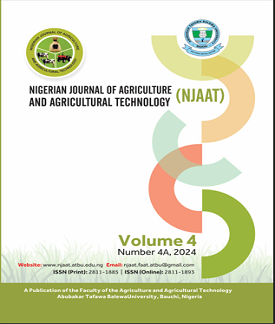EGGSHELL AND HATCHERY WASTE: PATHWAYS TO SUSTAINABLE BIOMATERIALS AND WASTE MANAGEMENT
DOI:
https://doi.org/10.59331/njaat.v4i4A.874Keywords:
Waste, Valorization, Eggshells, Hatchery, ProximateAbstract
This study investigates the potential for channeling eggshells and hatchery waste into valuable products, emphasizing the economic and environmental benefits of waste valorization in the poultry industry. Samples of chicken and quail eggshells, along with hatchery waste—including unfertilized and dead-in-shell embryos were collected from reputable hatcheries in Jos, Plateau State, and processed in Bauchi. Proximate composition analysis revealed that chicken eggshells contained 46.71% ash, 38.19% nitrogen-free extract (NFE), and 867.20 KCal/Kg of metabolizable energy, while quail eggshells had 40.41% ash, 39.52% NFE, and 849.46 KCal/Kg. Hatchery waste analysis showed that quail dead-in-shell had the highest crude protein content of 21.89%, while chicken unfertilized eggs had a crude protein level of 10.22%. The study also included a survey of 50 poultry farmers, revealing that 54% strongly agreed on the importance of economic considerations in waste valorization, with a mean score of 4.24. Furthermore, 44% strongly agreed on the environmental benefits of waste valorization, leading to a mean score of 4.10. The results indicated that both eggshells and hatchery waste are not only rich in nutrients but also present substantial opportunities for creating new revenue streams, thereby enhancing economic sustainability. The study concludes that implementing waste valorization practices can significantly reduce waste disposal costs, mitigate environmental impacts, and contribute to a circular economy in poultry farming. Based on the result of this study, increasing awareness and training among farmers, encouraging collaboration, and promoting policy support for sustainable waste management practices are recommended.
Downloads
Downloads
Published
How to Cite
Issue
Section
License
Copyright (c) 2024 Nigerian Journal of Agriculture and Agricultural Technology

This work is licensed under a Creative Commons Attribution-NonCommercial-ShareAlike 4.0 International License.
This work is licensed under a CC Attribution-NonCommercial-ShareAlike 4.0







